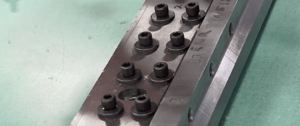 Over 85+ years of manufacturing converting machinery, ELSNER has quite a list of FAQs! That's why we're launching ELSNER Tech Talk: a series that aims to help our customers by sharing our years of experience in manufacturing, automation, machinery, converting and machining.
Over 85+ years of manufacturing converting machinery, ELSNER has quite a list of FAQs! That's why we're launching ELSNER Tech Talk: a series that aims to help our customers by sharing our years of experience in manufacturing, automation, machinery, converting and machining.
Check out this installment: Perforator Blade Tips:
Quality perforator blades provide ultimate in performance
When you buy a perforator blade from Elsner, it is ground to a thickness of 0.250 and a width of 2.000. It is made of hardened steel and when properly adjusted can provide months of performance. When it comes to perf blades we've seen it all over the years. We once had a customer leave the same blade in the machine for several years because they had some turnover in the maintenance department and the training and machine knowledge was lost. We don't recommend this, but nonetheless, the machine kept producing which is a testament to our blades.
Quality Control: What to remember when adjustments are needed
Your quality control procedures will tell you when the blade is worn out or in need of adjustment. There are a couple of things to remember when this time comes.
1. New blades have two cutting edges. If your blade has lost its edge, you can flip the blade over (long ways) to use the fresh side.
2. Blades can be re-sharpened. If you send your blades back to Elsner, for under $150 we can sharpen them and get them turned around in just a few days. When we sharpen the blades, we grind on the narrow end of the blade (reducing the 2.000 dimension). Both the rotary and anvil blades can be sharpened in the same manner. The slots in the blades allow for about 1/8” of adjustment, therefore we can keep sharpening until just 1/16” of material has been removed for rotary (or plain) blades. The notches in the patterned anvil blades are typically .063” deep, therefore you can only sharpen to 1.970” and leave enough notch to be effective.
Additional tips that should have been made clear with your initial training by an Elsner technician:
1. NEVER rotate the blade backwards. Rotating the blade opposite of the normal cutting direction can ruin the cutting edge.
2. Make only slight adjustments on the blade set screws. Turn them only a fraction of an rotation on each fine adjustment.
3. Backing out the set screws does not move the blade.
4. When using the ‘quick change’ cartridges, you need to keep the cartridges with the rotary blade they have been set for. Swapping between machines will not work. When it is time to replace, adjust or re-sharpen a rotary blade, all corresponding ‘quick change’ cartridges need to be reset.
For more info on blade sharpening or any other ELSNER solution, contact us: eew@elsnereng.com
Check out this video about the Perforator Tips: